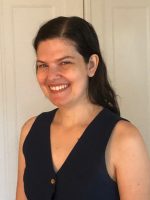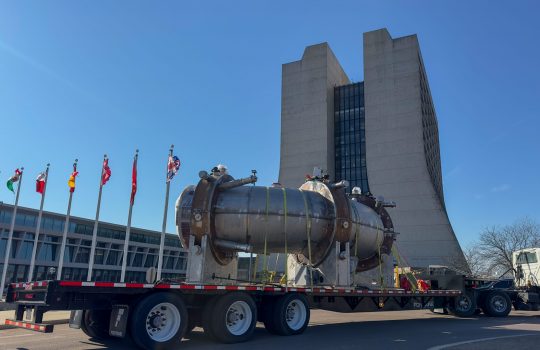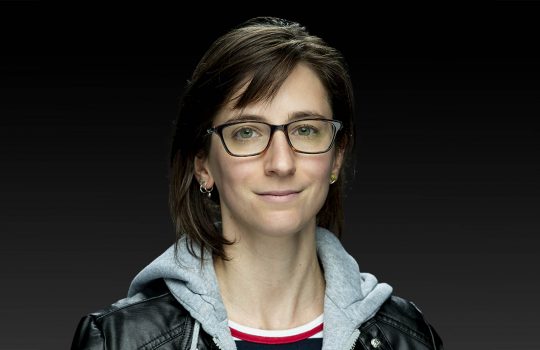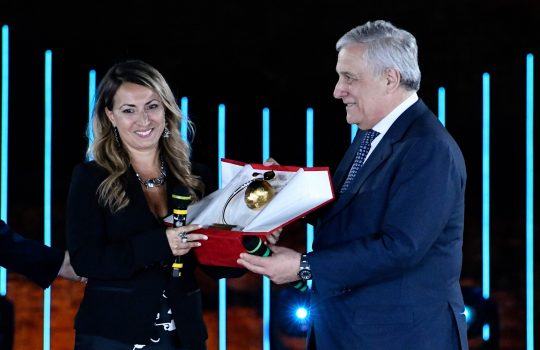Postdoctoral scientist Adi Ashkenazi of the Massachusetts Institute of Technology has earned the Universities Research Association 2020 Tollestrup Award for her research into neutrinos, ghostly particles that can pass through solid matter at high speeds without slowing.
The URA Tollestrup Award, named for the late Fermilab scientist Alvin Tollestrup, is given annually and includes a $5,000 honorarium.
“The Tollestrup Award has a tradition of recognizing postdocs who are making creative and essential contributions to Fermilab experiments, and Ashkenazi faced fierce competition within this group,” said award committee chair Michael Mulhearn, an associate professor of physics at the University of California Davis. “Ashkenazi’s improvements to modeling neutrino interactions, born of a productive collaboration with our colleagues in nuclear physics, are of far-reaching consequence and will be essential to the success of next-generation neutrino experiments.”
Ashkenazi was cited “for substantial improvements to the modeling of neutrino interactions using electron scattering data and widespread contributions to data acquisition, background modeling and systematics on MicroBooNE,” a Fermilab neutrino experiment.
“I feel very honored to get this award and grateful for many people I work with,” Ashkenazi said.
These include her MIT mentor, Or Hen, her colleagues in the Electrons for Neutrinos and CLAS collaborations at Thomas Jefferson National Accelerator Facility and those in the MicroBooNE collaboration at Fermilab.
“These are exciting times for neutrino physics because the new generation of experiments is now being constructed and will be commissioned in the coming years,” said Ashkenazi, a spokesperson for Electrons for Neutrinos, the collaboration that uses results produced by CLAS.
“These are exciting times for neutrino physics because the new generation of experiments is now being constructed and will be commissioned in the coming years.”
Neutrino detection is dependent on the neutrino’s interaction with atomic nuclei.
“The idea is to learn from the nuclear physics community and to facilitate knowledge-sharing between the neutrino and the nuclear communities,” said Ashkenazi, who works in parallel at the MicroBooNE and CLAS experiments.
In a sense, the two experiments are quite similar. MicroBooNE measures the interactions of neutrinos, and CLAS those of electrons, with the same atomic nuclei. Ashkenazi and her collaborators hope to use the results to improve their simulations of these complex particle interactions with the nucleus.
“Adi’s work perfectly exemplifies the powerful creativity and initiative that Alvin greatly valued in young physicists.” said URA Executive Director Marta Cehelsky. “She is highly deserving of this honor.”
Both electrons and neutrinos experience similar weak-force interactions with the nuclei, but electrons, because of their electric charge, are more accessible to experiments. Ashkenazi’s approach is to use electrons to understand the precise details of these weak-force interactions and thus better model the much more elusive neutrinos.
Ashkenazi’s honors include the Israel National Postdoctoral Award for Advancing Women in Science from the Weizmann Institute of Science and an Intensity Frontier Fellowship from Fermilab. She completed her graduate research at Tel Aviv University working on the ATLAS experiment at the Large Hadron Collider, then switched to neutrinos.
“Neutrinos are the only elementary particles that cannot be directly detected in ATLAS,” she said. “It ignites your curiosity to search for those particles that often go undetected by experiments.”
“It ignites your curiosity to search for those particles that often go undetected by experiments.”
Neutrino research may help physicists gain a better understanding of the origin of the universe, including the origin of matter and the unification of the forces that hold it together. The Standard Model, a set of theories that describes the properties of most elementary particles and their binding forces, predicted that neutrinos would have no mass. Given that they have a tiny mass, they may provide a path to the discovery of new physics that goes beyond the Standard Model.
The neutrino collaborations expect to produce answers to some of the big questions in the field within a decade: Can neutrinos explain the asymmetry between matter and antimatter? How much do neutrinos weigh?
“Even if we’ll not find what we’re looking for, we could help rule out certain neutrino theories. That’s also interesting,” Ashkenazi said.
Ashkenazi will continue her work as a senior lecturer at Tel Aviv University, where she will work on the international Deep Underground Neutrino Experiment, hosted by Fermilab. Her group will be the first Israeli group to collaborate on DUNE.
Fermilab is managed by the Fermi Research Alliance LLC for the U.S. Department of Energy Office of Science. FRA is a partnership of the University of Chicago and Universities Research Association Inc.
Fermilab neutrino research is supported by the DOE Office of Science.
Fermilab is supported by the Office of Science of the U.S. Department of Energy. The Office of Science is the single largest supporter of basic research in the physical sciences in the United States and is working to address some of the most pressing challenges of our time. For more information, visit science.energy.gov.




